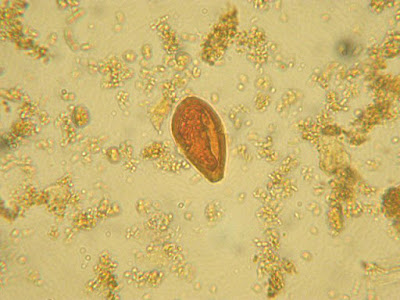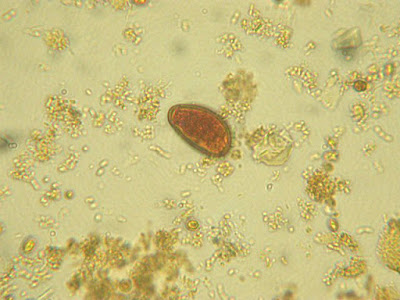I have a fun case for you this week from Dr. Richard Bradbury! The following structures were seen in a stool sample from 2-year old child from a rural southern Australia with mucoid diarrhea, abdominal pain and poor weight gain. Both an unstained web prep and iodine-stained prep are shown. The size of these objects ranges from 26–32 μm long by 16–17.5 μm wide. Identification?
Tuesday, October 13, 2020
Subscribe to:
Post Comments (Atom)









16 comments:
Based on the first 3 images and taking into account the size, I would have said Clonorchis sinensis. There is no abopurcular knob visible though. The presentation in a patient in Australia with no stated travel from Asia also does not fit. So basically I'm not certain!
It’s possible the good doctor is trying to bury the lead and the patient is an Asian immigrant. This would make C. sinensis or O. viverrini far more likely an identification. Otherwise I agree with Sam, a mysterious case.
Metagonimus yokogawai or Heterophyes heterophyes
It appears that the ova are operculated and thus it is a trematode. The size is compatible with O. viverrini however the general shape with asymmetric on some would say otherwise. The morphology is not the one of C. sinensis.
Florida Fan
Great thoughts everyone! I will add that the patient has NOT travelled outside of Australia. This information may help you, or may just muddy the waters further :)
If it doesn’t fit we must acquit! All parasites are innocent ☺️
Given the shape (asymmetrical; with operculum and abopercular knob), the size of the eggs, and the geographical distribution, i am inclined to Brachylaima cribbi. Intriguing case.
Back in the good old days we would identify such eggs found in various mammals as one of many species of the Heterophylid.
Previous proposals are possible. But I thought I would mix it up a bit with a different hypothesis. There is in fact a Hetrerophyld fluke, native to Australia, with operculate eggs similar to the size ranges given. It is associated with fish and shorebirds and has been envolved in human GI Infections. Goes by the name of Haplorchis vanissimus. Indeed only an hypothesis, so I will fall back on my ancient skills and identify it as an unidentifiable Heterophlid egg.
Bravo Dr. Rocha, I think you've got it.
Nice! I’ve never even heard of this one!👏🏼
Nice Dr. Rocha! I think you’re right!
Asymmetrical, operculated and small...
and if it is sent in by Dr. Richard Bradbury it has to be something as exotic as Brachylaima cribbi...
;-)
Thank you Dr. Rocha, this is one most of us have not seen before.
Florida Fan
Dicrocelium dendriticum
Post a Comment